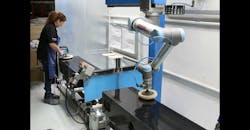It’s been 10 years since collaborative robots appeared on the manufacturing scene. First viewed as a lab experiment by global manufacturers that would buy one or two, sending them off to their innovation centers for testing never to be seen on the production floor, cobots now are hard at work in many sectors all around the world.
For small and mid-size manufacturers that don’t have an army of automation engineers, cobots can be a dream come true. These companies can especially be hard hit by labor shortages, economic volatility, and competitive pressures, so the ability to deploy cobots without major investments in time, talent, and money can be a game-changer for many.
What I hear when I talk with these companies most often is: “How can I get started?”
Each company is, of course, different, but there are some things I recommend that manufacturers look for when considering where cobots can be put to work. Watch your people at work. What you see will help you identify work that is ideal for automation with cobots:
1. Where are people waiting for some aspect of the task process to be completed?
Any time a person is standing around waiting for a process to be complete before they can move on to the next step is time—and money—wasted.
2. What tasks are clearly too simple for people to be wasted on?
Think of things like putting parts into a box, tending to a CNC machine, transferring parts from one line to another, inserting screws, and loading/unloading a rotary indexing table. If a cobot can do it, why wouldn’t you give the person something more valuable to do?
3. What tasks can be unbundled or have many sub-tasks?
I’ve seen instances where the steps in a task are assembled into a start-to-finish model as a way to make the work less boring, but the fact is that a string of boring tasks is likely to still be boring.
Look for tasks where the person today is doing just one or two things. Unlike people, robot “hands” are typically good at one or two things. Asking the robot to do more tasks can sometimes require the robot to switch hands, which can be done, but adds cost and complexity. One example of a typical two-step task requires taking a part out of a machine and inspecting it.
4. Which employees are not smiling?
If a person’s expression or body language reflects boredom, frustration or apathy, it’s a good bet that you aren’t taking advantage of the potential they have to add real value to your process.
5. What is the person doing with their hands?
People have amazing hands that can do a great many very complicated things. Robots are not so lucky. Many robots use simple vacuum suction cups to pick something up, or two-finger grippers to grip a part like you or I might hold a glass of water. If the task requires finger dexterity, it’s not a good candidate for automation with cobots—yet.
If you are wondering if automation could help you increase productivity, improve quality, and lower costs, start by walking your production floor and observing your employees at work. It will tell you a lot about where and how to get started, I guarantee it.
What do you see when you watch people at work? What kinds of tasks have you found might be better for a cobot?
Jim Lawton, VP of Product Management at Universal Robots AS, has built his career building organizations that give manufacturers new and effective ways to capitalize on the intersection of technology and business performance. From early days in e-commerce and supply chain optimization to today's collaborative robots, Jim thrives on being on the forward edge of changing what world-class manufacturing looks like.
About the Author
Jim Lawton, Universal Robots
Jim Lawton, VP-Product Management at Universal Robots AS, has built his career building organizations that give manufacturers new and effective ways to capitalize on the intersection of technology and business performance. From early days in e-commerce and supply chain optimization to today's collaborative robots, Jim thrives being on the forward edge of changing what world-class manufacturing looks like.
